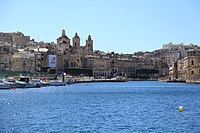This is a list of cities in Malta. By the usual standards that most other countries use when designating a city, Malta's cities would be too small to be considered such, and in fact Malta is sometimes regarded as a single city-state. [1] Malta's cities are regarded as such because they received the designation of città at some point during their history. In Maltese law, no distinction is made between cities, towns, and villages; city status is purely honorary and colloquial. Malta is divided into 68 local councils. The local councils which formerly had city status all feature a mural crown on the crest of their coat of arms. The table shows the historical cities:
| Within current local council | Historical city | Year granted | Image | Population (2014) [2] | Notes |
|---|---|---|---|---|---|
| Città Vittoriosa (Victorious City) | 1530 |  | 2,629 | Capital city from 1530 to 1571, and one of the Three Cities. City status confirmed following the Great Siege of Malta in 1565. [3] | |
| Città Cospicua (Conspicuous City) | 1722 |  | 5,395 | One of the Three Cities. City status granted in 1722 by Grand Master Marc'Antonio Zondadari. [4] | |
| Città Notabile (Notable City) |  | 292 | Capital city from antiquity to 1530. | ||
| Città Pinto ( Pinto's City) | 1743 |  | 16,779 | City status granted on 25 May 1743 by Grand Master Manuel Pinto da Fonseca, following a request made by Don Giuseppe Vella. [5] | |
| Città Victoria ( Victoria's City) | 1887 |  | 6,901 | Capital city of Gozo. City status granted on 10 June 1887 by Queen Victoria, following a petition made by Bishop Pietro Pace and Chief Justice Adrian Dingli on occasion of Victoria's Golden Jubilee. [6] | |
| Città Invicta (Invincible City) | 1565 |  | 2,784 | One of the Three Cities. City status granted following the Great Siege of Malta in 1565. [7] | |
| Città Ferdinand ( Ferdinand's City) | 1797 |  | 8,367 | City status granted on 30 December 1797 by Grand Master Ferdinand von Hompesch zu Bolheim, following a petition made by Don Salvatore Corso and the inhabitants. [8] | |
| Città Umilissima (Humblest City) | 1571 |  | 6,444 | Capital city since 18 March 1571. [9] | |
| Città Hompesch ( Hompesch's City) | 1797 |  | 15,404 | City status granted on 14 September 1797 by Grand Master Ferdinand von Hompesch zu Bolheim, following a request made by Don Carlo Caruana and the inhabitants. In 1801, the Hompesch Gate was built to commemorate this event. [8] | |
| Città Rohan ( Rohan's City) | 1777 |  | 11,903 | City status granted on 21 June 1777 by Grand Master Emmanuel de Rohan-Polduc, following a petition made by the inhabitants. In 1798, the De Rohan Arch was built to commemorate this event. [10] | |
| Città Beland (Beland's City) | 1797 |  | 11,508 | City status granted on 30 December 1797 by Grand Master Ferdinand von Hompesch zu Bolheim, following a petition made by Don Giacomo Michele Tortella and the locals. [8] He named it after his mother's maiden name. |
